Chocolate Chip Cookies Recipe
This post may contain affiliate links. Read my full disclosure policy.
A few tweaks to the classic Nestlé® Toll House® recipe make this the best chocolate chip cookie recipe ever.
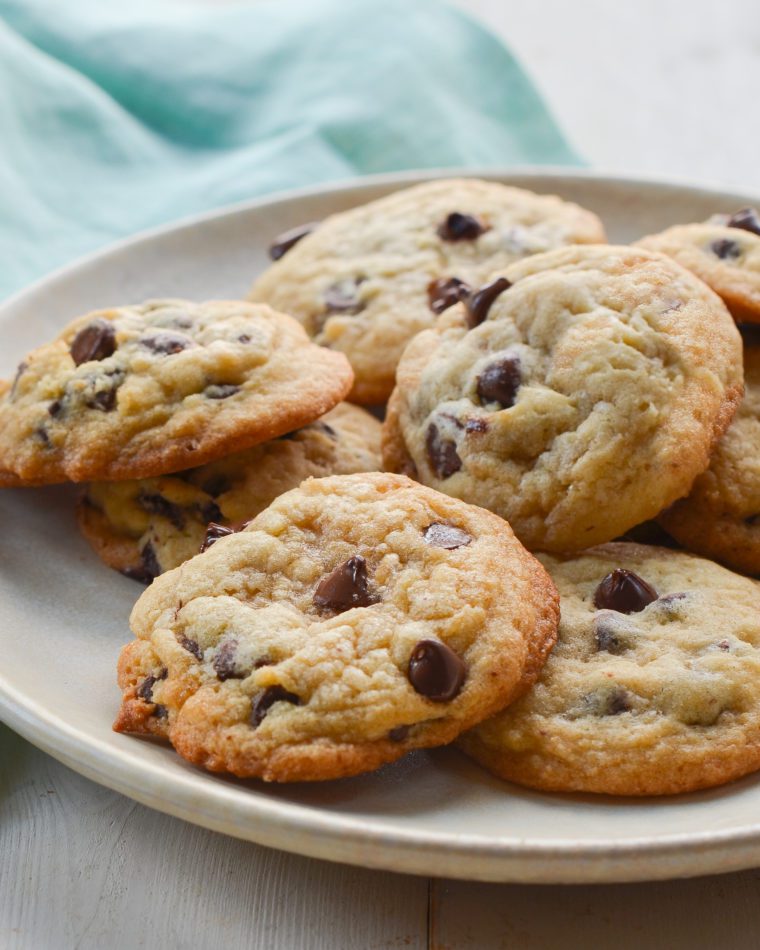
The simplest recipes are typically the hardest to get right, and classic chocolate chip cookies are a perfect example. The most widely-used chocolate chip cookie recipe is found on the back of the Nestlé® Toll House® bag, but if you follow it to the letter, the cookies often come out flat as pancakes. Over the years, I’ve experimented with various techniques in search of the perfect chocolate chip cookie, from resting the dough for days to browning the butter to using different types of flour. However, I found that these methods didn’t produce a noticeable improvement in taste and texture—and, honestly, who wants to go to all that trouble for cookies?!
Instead, I tweaked the classic and easy Toll House® recipe to make it more reliable and tastier. These chocolate chip cookies are thick with a chewy, moist center and slightly crisp exterior, and they strike the perfect balance of sweet and salty flavor. Before you start baking, be sure to read my best baking tips to ensure success.
“I was a bit skeptical that these would be ‘the best’ as I have many recipes that make really good chocolate chip cookies. I was wrong! OMG, these cookies are outstanding.”
What You’ll Need To Make Chocolate Chip Cookies
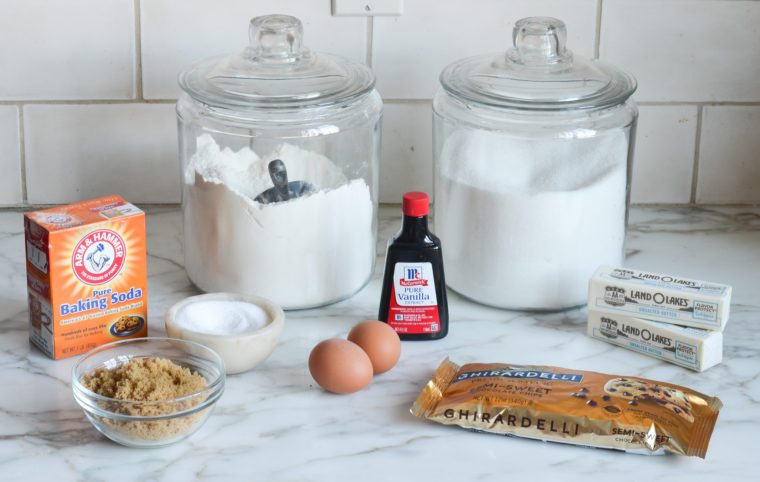
- Butter: Provides richness and flavor to the cookies while contributing to their tender texture.
- Granulated Sugar and Dark Brown Sugar: Sweeten the dough, adding moisture and contributing to the cookies’ chewiness and caramelization. Feel free to substitute light brown sugar here.
- Vanilla Extract: Enhances the overall flavor profile with its warm and aromatic notes.
- Eggs: Bind the ingredients together and add structure to the dough.
- Baking Soda: Help the cookies rise and spread, resulting in a soft and chewy texture.
- All-Purpose Flour: Forms the base of the dough, providing structure and stability to the cookies.
- Semi-Sweet Chocolate Chips: These add sweet pockets of chocolate flavor. You can easily swap them out milk chocolate chips, white chocolate chips, butterscotch chips, peanut butter chips, or chocolate chunks for larger, meltier bites. To add crunch, mix in toffee bits or chopped nuts like walnuts, pecans, or almonds. You can even add candy pieces like M&M’s.
- Jump to the printable recipe for precise measurements
Step-By-Step Instructions
In the bowl of an electric mixer fitted with the paddle attachment or beaters, combine the butter and both sugars.
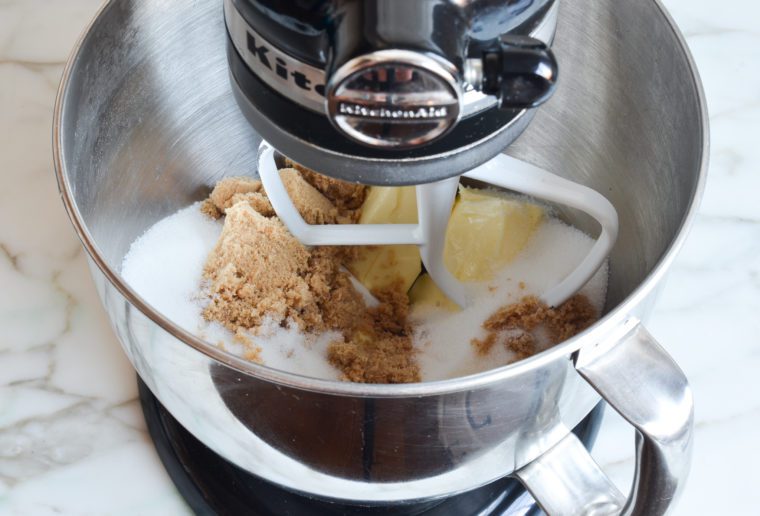
Beat on medium speed (or high speed if using a hand mixer) for 3 minutes, or until light and fluffy, scraping down the sides and bottom of the bowl as necessary.
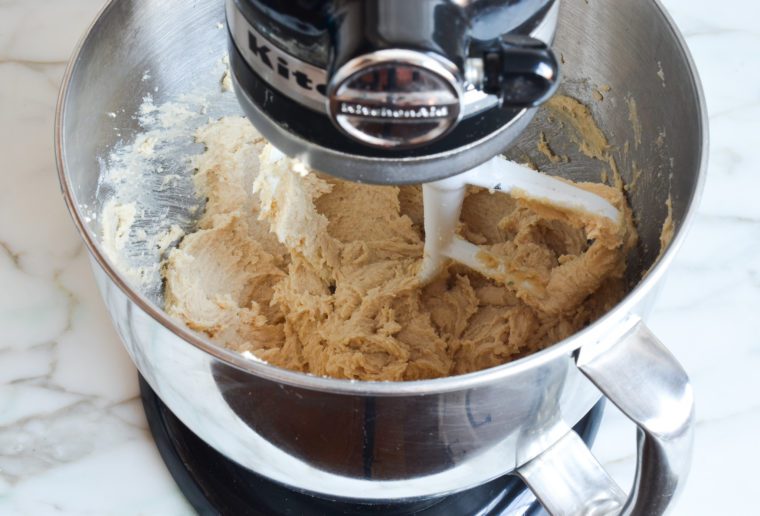
Add the vanilla and eggs.
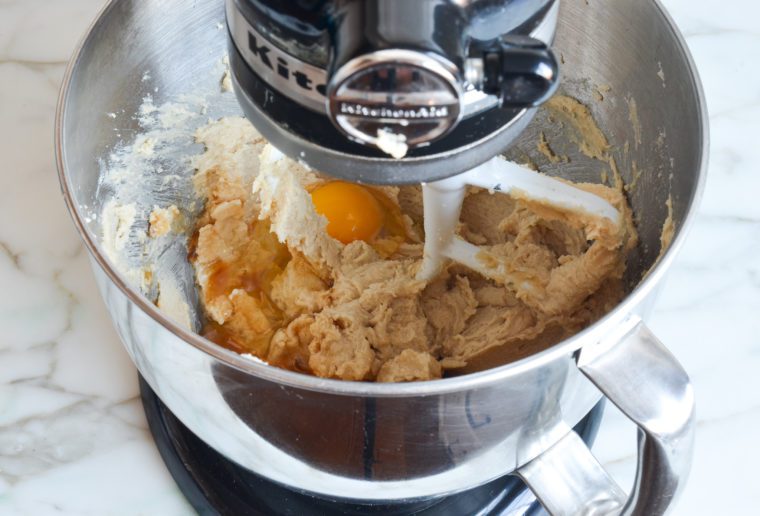
Beat for 2 minutes more, then scrape down the bowl.
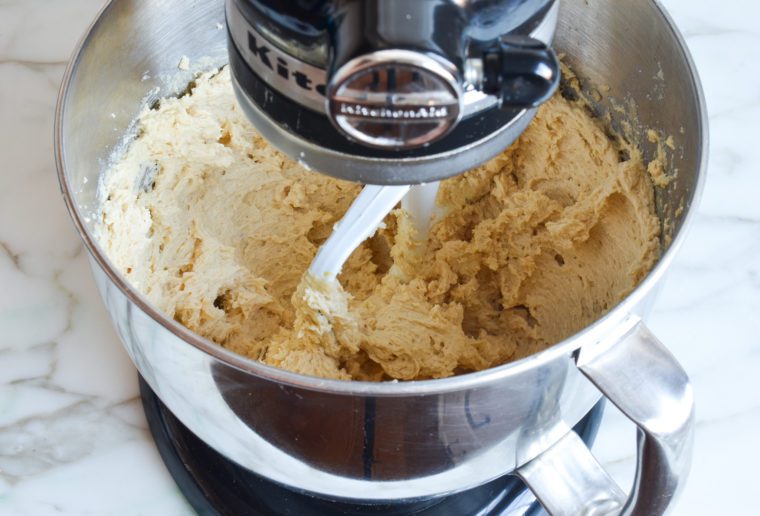
Add the salt and baking soda and beat briefly until evenly combined, then add the flour.
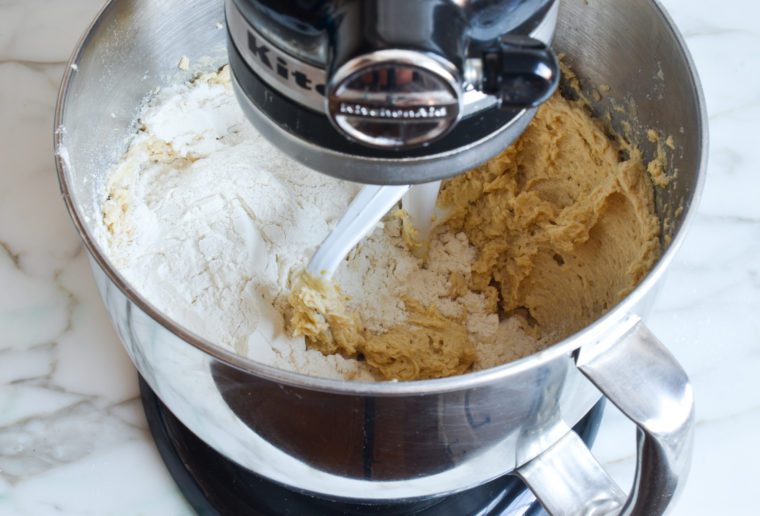
Mix on low speed until the dough is uniform.
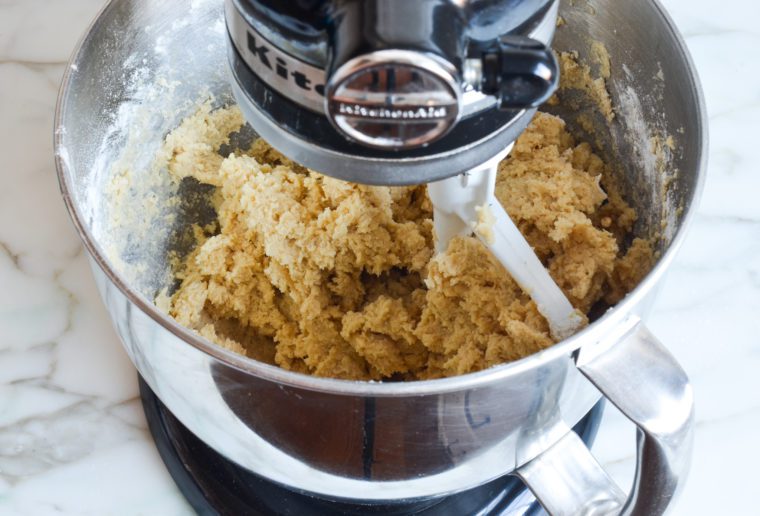
Add the chocolate chips.
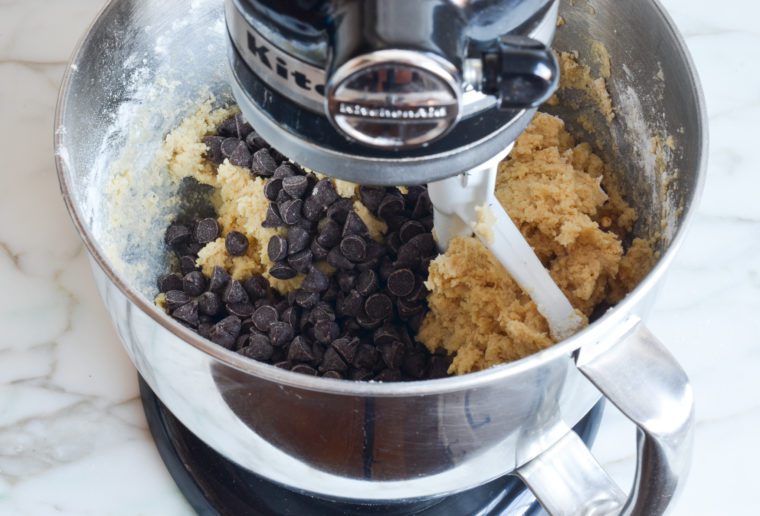
Mix until evenly combined.
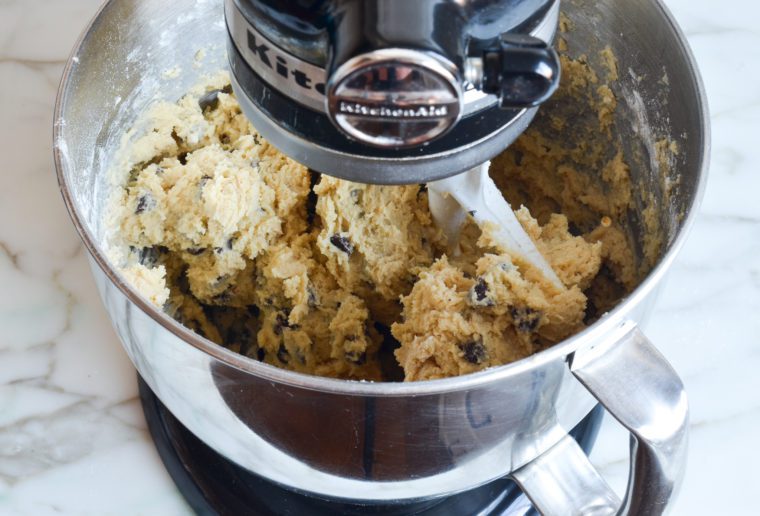
Cover the bowl with plastic wrap or scrape the dough mixture into an airtight container and let rest in the refrigerator until firm, a few hours or overnight. (Alternatively, if you don’t want to wait, form the dough into balls as instructed below, arrange on the baking sheets, and chill in the fridge until firm, about 30 minutes.)
Drop the dough in firmly packed 1.5-tablespoon balls onto the prepared baking sheet, spacing them about 2 inches apart. (I use a 1.5-tablespoon cookie scoop.) For thick cookies, it’s important to really pack the dough in the scooper or with your hands.
Pro Tip: If you’d like to see the chocolate chips on the surface of the cookies, hold back about 1/3 cup chocolate chips and dot them on the dough balls, pressing them in slightly, before baking.
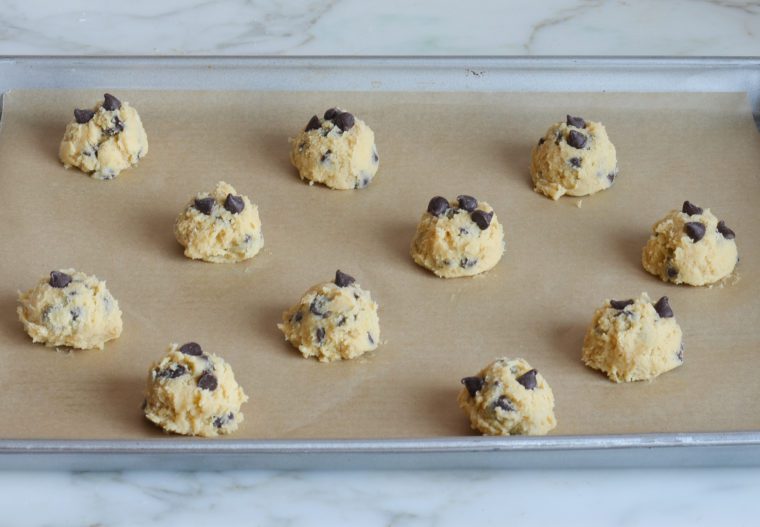
Bake for 11 to 13 minutes, until golden brown around the edges but still soft and pale in the center.
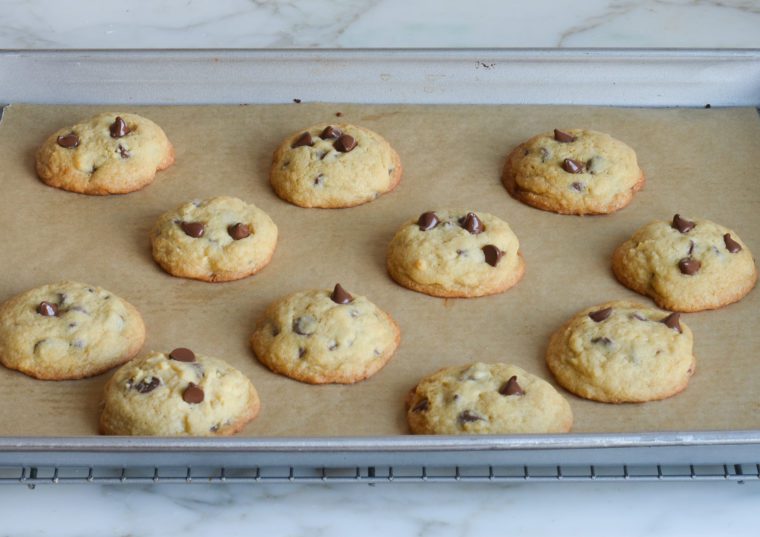
Let cool for a few minutes on the baking sheet, then transfer to a wire rack to cool completely. The cookies will keep in an airtight container at room temperature for up to 3 days.
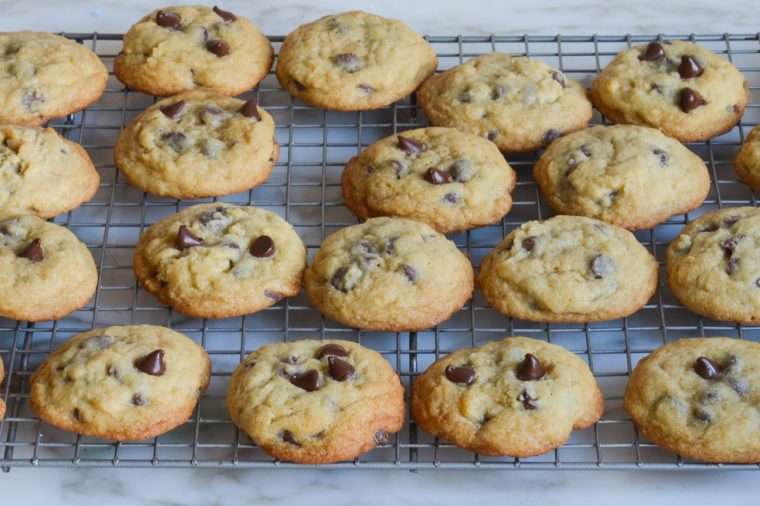
Frequently Asked Questions
Yes, this recipe will work using a 1:1 gluten-free flour blend. However, you will have even better results making my gluten-free chocolate chip cookies, which are the best I’ve tried.
King Arthur All-Purpose Flour has a higher protein content compared to other brands, around 11.7%, which gives the cookies more structure. The flour’s ability to absorb more moisture means your dough is less likely to spread too much, giving you plump, delicious cookies.
This recipe is specifically designed to prevent excessive spreading, incorporating the correct flour-to-fat-to sugar ratio, especially if you use the recommended King Arthur Flour. Additionally, it’s important to make sure your butter is soft but not melted, and chill the dough before baking. Chilling solidifies the fat, which helps the cookies maintain their shape better as they start to bake.
Yes, you can freeze chocolate chip cookie dough, and it’s a great way to have fresh cookies on demand. Portion the dough into individual cookie balls, freeze them on a baking sheet, and then transfer them to a freezer-safe bag or container for up to 3 months. When you’re ready to bake, you can bake the frozen dough balls directly from the freezer, adding a few extra minutes to the baking time.
Video Tutorial
You May Also Like
Chocolate Chip Cookies
A few tweaks to the classic Nestlé® Toll House® recipe make this the best chocolate chip cookie recipe ever.
Ingredients
- 2 sticks (1 cup) unsalted butter, at room temperature
- ⅔ cup granulated sugar
- ¾ cup (packed) dark brown sugar (fine to substitute light)
- 1 teaspoon vanilla extract
- 2 large eggs
- 1 teaspoon salt
- 1 teaspoon baking soda
- 2½ cups all purpose flour, spooned into measuring cup and leveled off (see note)
- 2 cups (12 oz) semi-sweet chocolate chips, best quality such as Ghirardelli
Instructions
- In the bowl of an electric mixer fitted with the paddle attachment or beaters, beat the butter and both sugars on medium speed (or high speed if using a hand mixer) for 3 minutes, or until light and fluffy, scraping down the sides and bottom of the bowl as necessary. Add the vanilla and eggs and beat for 2 minutes more. Scrape down the bowl. Add the salt and baking soda and beat briefly until evenly combined. Add the flour and mix on low speed until the dough is uniform. Mix in the chocolate chips.
- Cover the bowl with plastic wrap or scrape the dough into an airtight container and let rest in the refrigerator until firm, a few hours or overnight. (Alternatively, if you don't want to wait, form the dough into balls on the baking sheets as instructed below, and chill in the fridge until firm, about 30 minutes.)
- Preheat the oven to 350°F and set a rack in the middle position. Line a 13 x 18-inch baking sheet with parchment paper.
- Drop the dough in firmly packed 1.5-tablespoon balls onto the prepared baking sheet, spacing them about 2 inches apart. (I use a #40/1.5-T cookie scoop with a wire trigger.) For thick cookies, it's important to really pack the dough in the scooper or with your hands. Bake for 11 to 13 minutes, until golden around the edges but still soft and pale in the center. Let cool for a few minutes on the baking sheet, then transfer to a wire rack to cool completely. Repeat with the remaining cookie dough, refrigerating the dough between batches. The cookies will keep in an airtight container at room temperature for up to 3 days.
- Note: I highly recommend King Arthur All-Purpose Flour for this recipe – it's higher in protein than other brands and helps the cookies plump up and hold their shape.
- Freezer-Friendly Instructions: The cookie dough can be frozen for up to 3 months. To freeze, roll the dough into balls, let set on a baking sheet in the freezer for about 1 hour, then place in a sealable bag and press out as much air as possible. Bake as needed directly from the freezer. (Allow 1 to 2 minutes longer in the oven.) The baked cookies can also be frozen for up to 3 months. Let the cookies cool completely and store in an airtight container separating layers with parchment paper or aluminum foil. Before serving, remove the cookies from the container and let them come to room temperature.
Nutrition Information
Powered by ![]()
- Per serving (40 servings)
- Serving size: 1 cookie
- Calories: 69
- Fat: 4 g
- Saturated fat: 2 g
- Carbohydrates: 9 g
- Sugar: 5 grams
- Fiber: 0 g
- Protein: 1 g
- Sodium: 36 mg
- Cholesterol: 11 mg
This website is written and produced for informational purposes only. I am not a certified nutritionist and the nutritional data on this site has not been evaluated or approved by a nutritionist or the Food and Drug Administration. Nutritional information is offered as a courtesy and should not be construed as a guarantee. The data is calculated through an online nutritional calculator, Edamam.com. Although I do my best to provide accurate nutritional information, these figures should be considered estimates only. Varying factors such as product types or brands purchased, natural fluctuations in fresh produce, and the way ingredients are processed change the effective nutritional information in any given recipe. Furthermore, different online calculators provide different results depending on their own nutrition fact sources and algorithms. To obtain the most accurate nutritional information in a given recipe, you should calculate the nutritional information with the actual ingredients used in your recipe, using your preferred nutrition calculator.

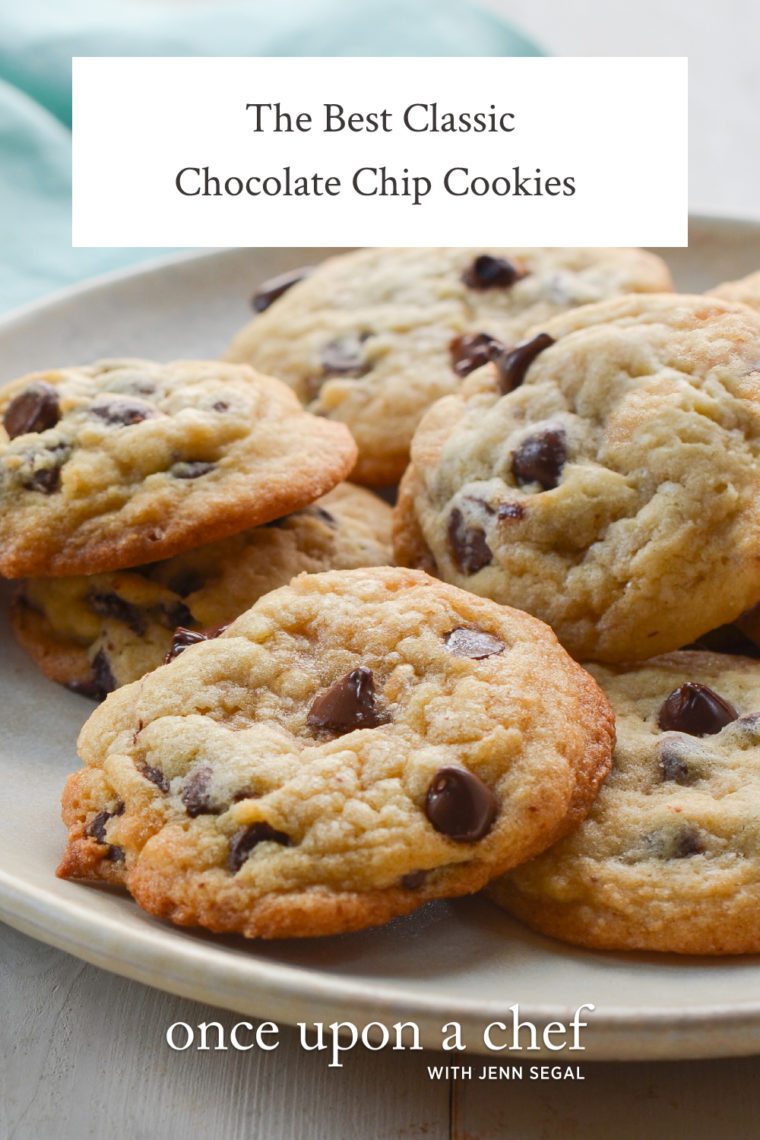
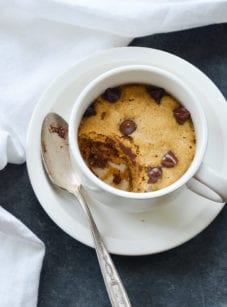
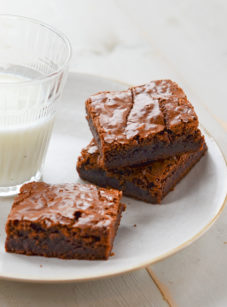
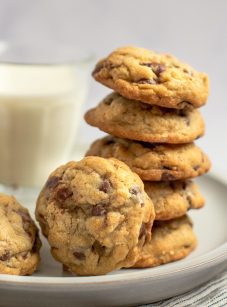
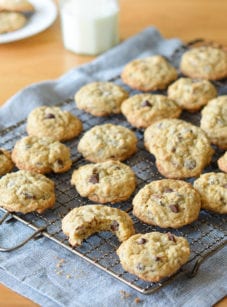
Finally, the quintessential chocolate chip cookie – thank you Jenn! I have tried many recipes over the years that use cumbersome techniques or special ingredients, but the “classic chocolate chip cookie” has always eluded me until now. This is perfection.
Hi Jennifer:
RE: Oatmeal and Walnut addition – measurement needed?
I would like to try this recipe as I know it will be good. I have promised Oatmeal, Chocolate Chip and Walnut cookies to a friend. In order to make them with oatmeal, how much oatmeal and walnuts would you suggest I add to make a delicious cookie. I will follow your instructions to a “T”. Thanks in advance. Thank you and Blessings, Susan
Hi Susan, Based on what you’re looking for, I’d suggest this recipe instead (and you can swap the pecans for walnuts). Hope your friend enjoys!
Pancake vs. rounded with crispy edges all depends on the pan you use! Using an aluminum baking pan yields a flat pancake. Using a dark gray nonstick cookie sheet yield a perfect cookie, rounded soft and chewy with crispy edges! Same recipe, different pan.
I plan to make these soon and will be sure to use King Arthur flour.
There were differing opinions in recent years, some professional bakers saying that the higher protein in KA flour resulted in a ‘tough’ cookie. When I used a lower protein flour, especially for chocolate chip cookies, they would spread and flatten out.
Glad to see that you recommend King Arthur!
I agree with you. I have tried this recipe many, many times and it always come out flat like pancakes. But for the past 3 years, I have been putting the dough in the refrigerator for a few hours before baking and when it’s baked, it rises perfectly and so soft in the inside!! Yumm!!
Have found that one of the biggest problems in baking is the brand and flour measurement. Books have been written on how to measure flour, differences in brands, etc…e.g., “one cup” of Pillsbury flour” typically is not the same as “one cup” of King Arthur, and can vary enough in volume that it can change results substantially. Wondering if you could add the brand and weight (grams/ounces) of flour for your recipe which I’d like to try. Thanks.
Hi Ron, I have the best luck with King Arthur flour so I always would recommend that for baking. And the great majority of my recipes (including this one) include conversions to weight measurements. To view them, scroll down to the recipe, and immediately under the recipe title on the right side, you’ll see a little toggle. If you move it from “cup measures” to metric, you’ll see measurements that will work for you. Hope that helps and that you enjoy the cookies if you make them!
A kitchen scale is a small investment that yields big dividends–never more so than when baking–and the chameleon-like qualities of different flours. I consider it an essential tool.
Thankfully most recipes provides such measures.
Thanks for your many contributions.
I can only get lower protein all purpose flour here in Colombia. I’m thinking of adding 1% vital wheat gluten to up the protein for a chewier cookie. Thoughts?
Hi Adriana, I think that would work.
I only keep salted butter on hand. To make it with salted butter, would I just decrease the salt added in or skip it all together? I’ve always wondered why recipes call for unsalted butter then add in salt. It seems redundant. What’s the difference?
Hi Cassie, The primary reason that recipes call for unsalted butter is that the amount of salt in salted butter varies by brand. This makes it harder to calibrate the rest of the seasoning in the recipe. While it does vary by brand, most salted butter has approximately 1/4 tsp. salt per stick, so you can use the salted butter and reduce the salt in the recipe as needed. Hope that helps!
Mom always refrigerated her chocolate chip cookie dough. And, usual, Mom was right! Your version is delicious and I will make again.
The recipe I use is almost identical to this one. It also calls for unsalted butter and placing dough in fridge. I think those two things are what makes the difference. I have never gone back to the Nestle recipe on the back of the package. The first time I made these the dough was rock hard coming out of the fridge and I thought “oops” these won’t bake up properly, but they did! The family gobbles these up. I have been asked many times “what do you put in these cookies?” It is the unsalted butter and hang time in the fridge for sure.
Can oil be substituted for the butter in this recipe?
Hi Gay, the one oil that would work is (solidified) coconut oil. Please LMK how it turns out if you try it!